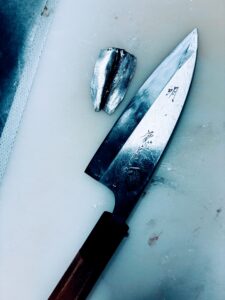Facing the “Face” of Tuna – What I Learned from Handling Fresh Bluefin Cheek Meat
Hello everyone, this is Sushi Batake. Today, I’d like to share a special experience—working with a rare part of the fish: the cheek meat of a fresh bluefin tuna.
You might not be too familiar with tuna cheek meat. That’s because it’s incredibly rare—only two small portions can be taken from a single fish, usually weighing just a few hundred grams in total.
The fibers are powerful, yet the surface glistens with delicate fat. Truly, this is a material that makes you feel honored to be a craftsman.
Flavor Born from Movement—Firmness Born from Strength
The cheek is one of the most active muscles a tuna uses while swimming. And that’s exactly why it’s packed with flavor. It carries the bold depth of lean meat, while also evoking the rich satisfaction of red meat—definitely one of the most expressive cuts.
However, its strength also presents a challenge. The moment I saw it, I thought, “This is better suited for nigiri than sashimi.” Why? Because the fibers are so tough that if you don’t score it deeply and delicately, it leaves an unpleasant texture in the mouth. It requires fine and careful knife work—no shortcuts here.
Adjusting the thickness is also key to creating harmony with the sushi rice. When cut just right, the meat and rice become one in each bite.
Reading the “Expression” of the Cheek
As a sushi chef, I’ve come to believe that every part of a fish has its own facial expression. Otoro is glossy and luxurious, chutoro is balanced and composed, akami is clean and straightforward. And the cheek? The cheek has a rugged yet gentle face—wild but warm.
Because the blood flavor is quite strong in this part, I chose to lightly sear the surface. Honestly, it looked like a piece of grilled beef at first glance (laughs). But once you bite into it, the impact is immediate. It’s not the kind of sushi that melts away quietly—it hits boldly, with intensity and character.
Reactions That Stay With Me
One customer told me, “This is the most memorable piece of tuna I’ve ever had.” That comment alone made my day. Another guest said, “Knowing which part of the fish we’re eating makes sushi way more fun.” That kind of feedback is what keeps me going.
Being able to explain each part, and seeing the moment a guest’s expression changes—that’s the real joy of handling rare cuts like this. Sushi becomes more than just food. It becomes an experience.
Dialogue Between Knife and Ingredient
The knife in the photo is my trusty yanagiba—my daily partner. The blade is made of high-carbon steel, and while it requires regular care, the reward is in the precision and beauty of the cut.
Especially when working with complex fibers like cheek meat, the quality of your knife work directly affects the taste. When the blade glides just right, you don’t need anyone to tell you—it simply feels right. That’s the moment you know you’ve connected with the ingredient.
Sushi is a form of dialogue. With the fish. With the tools. With the customer. It’s in those quiet conversations that I find purpose as a sushi chef.
Would You Like to “See the Face” of Fish Too?
Bluefin tuna shows many different faces depending on the part—back, belly, collar, and now cheek. Understanding the uniqueness of each cut brings a new level of depth and appreciation to sushi.
At Sushi Batake, I currently work at Sushikawa in Sasazuka, Tokyo, and I also provide private sushi catering and hands-on sushi-making experiences throughout the city. I’m happy to guide guests in English, making the experience accessible and enjoyable for international customers as well.
If you’re curious about rare cuts, or want to plan a special sushi event, feel free to get in touch. Whether you want to try something new or create a memorable occasion, I’d love to help.
Looking for a rare sushi experience in Tokyo? Sushi Batake is here to bring unforgettable flavors—right to your table.


